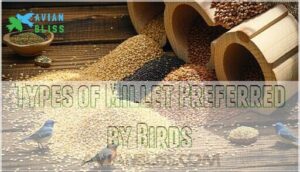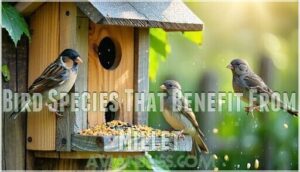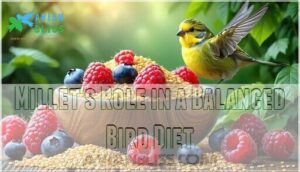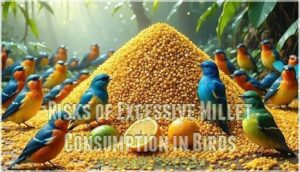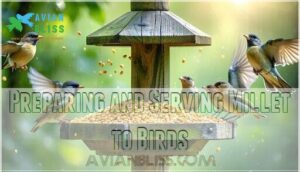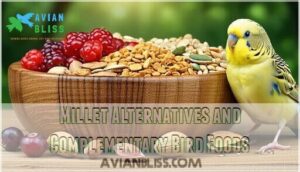This site is supported by our readers. We may earn a commission, at no cost to you, if you purchase through links.
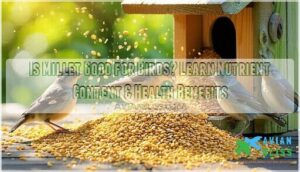
It’s packed with essential amino acids, B vitamins, and minerals like magnesium and phosphorus, which support strong bones, shiny feathers, and overall health.
Birds, especially seed-eaters, love varieties like white proso, red, and foxtail millet, and it’s a favorite for ground-feeding birds and even pet species.
While millet is nutritious, balance is key—too much can lead to weight gain or nutrient gaps, so it’s essential to mix it with other seeds or fresh foods for a well-rounded diet that supports overall health.
Curious about millet’s role in bird health? Keep reading!
Table Of Contents
- Key Takeaways
- Nutritional Value of Millet for Birds
- Types of Millet Preferred by Birds
- Bird Species That Benefit From Millet
- Millet’s Role in a Balanced Bird Diet
- Potential Health Benefits of Millet for Birds
- Risks of Excessive Millet Consumption in Birds
- Preparing and Serving Millet to Birds
- Millet Alternatives and Complementary Bird Foods
- Comparing Millet to Other Seed Options
- Pellets as a Nutritional Alternative to Millet
- Fresh Fruits and Vegetables to Supplement Millet
- Protein Sources to Balance Millet-Based Diets
- Which Birds Prefer Millet in Their Diet?
- Is Millet a Healthy Food Choice for Birds?
- What Type of Millet is Best for Feeding Birds?
- How Does Millet Compare to Other Birdseed Options?
- Are There Any Birds That Avoid Millet?
- Can Millet Be Mixed With Other Birdseed to Attract a Variety of Birds?
- Does Millet Have Any Nutritional Value for Birds?
- Can You Give Millet to Birds Every Day?
- What is The Most Critical Nutrient to Birds?
- What is The Nutritional Information on Millet?
- Frequently Asked Questions (FAQs)
- Why do birds eat millet?
- Is millet safe for birds?
- What can a bird eat instead of millet?
- Do parrots eat millet?
- Is white proso millet good for birds?
- Are pearl millets good for birds?
- Does millet have any nutritional value for birds?
- Can I feed my bird millet everyday?
- What is the most critical nutrient to birds?
- What is the nutritional information on millet?
- Conclusion
Key Takeaways
- Millet’s packed with carbs, protein, and fiber, giving birds energy, aiding digestion, and supporting muscle and feather health.
- It’s rich in vitamins like B1 and B6 and minerals like magnesium and calcium, promoting strong bones, immune health, and shiny feathers.
- Moderation’s key; too much millet can cause weight gain, nutritional imbalances, or dependency, so mix it with other seeds and fresh foods.
- Sprouting millet boosts its nutrients and makes it easier to digest, giving birds added health benefits.
Nutritional Value of Millet for Birds
Millet is packed with essential nutrients like protein, fiber, and slow-release carbohydrates that support your bird’s energy and overall health.
It also provides essential vitamins, minerals, and antioxidants that contribute to strong bones, shiny feathers, and a robust immune system.
Protein Content in Millet
Millet’s protein content makes it a solid choice for your bird’s diet, offering 11-13% protein that’s both digestible and effective for their health.
While it’s not the highest among protein sources, its quality and amino acid profile help birds thrive. Protein is essential for muscle development, feather growth, and overall well-being, making millet a reliable option for balanced bird nutrition.
Millet doesn’t just deliver protein—it pairs it with fiber for smooth digestion. This combination guarantees birds stay active and healthy without unnecessary fat. Whether your feathered friend is repairing muscles or growing shiny feathers, millet supports their needs.
- Supports muscle development and repair, keeping birds strong and agile
- Promotes feather growth, giving birds a glossy, healthy appearance
- Provides digestible protein, ideal for maintaining energy and well-being
Add millet to your bird’s diet for a wholesome, protein-packed meal.
Essential Amino Acids in Millet
In the context of bird nutrition, amino acids in millet play a key role in keeping your feathered friends healthy and active.
This tiny seed packs a punch with amino acid types like lysine, methionine, and threonine.
Lysine aids calcium absorption, which strengthens bones and supports egg production.
Methionine is essential for protein synthesis, ensuring muscle development and vibrant feather growth.
Meanwhile, threonine bolsters the immune system, helping birds stay resilient against illnesses.
Tryptophan, another amino acid in millet, promotes mood balance, reducing stress and keeping birds content.
Millet’s amino acid profile makes it a powerhouse for overall bird health.
To enhance these benefits, pair millet with other protein-rich foods, ensuring a well-rounded diet.
By including millet, you’re directly supporting feather growth, muscle strength, and even reproductive success in your birds.
Carbohydrates and Fiber in Millet
Your bird’s boundless energy owes a lot to millet’s carbohydrates and fiber, making it a powerhouse for sustained energy and digestive health.
This small seed works wonders for their overall well-being.
- Fiber benefits: Keeps their gut healthy and supports good bacteria.
- Carbohydrate types: Provides slow-release energy, avoiding sugar spikes.
- Sustained energy: Fuels flapping, chirping, and other daily activities.
- Digestion support: Promotes smoother digestion and nutrient absorption.
By including millet in their diet, you’re offering more than just food—you’re giving them the fuel they need to thrive, inside and out.
Vitamins and Minerals in Millet
You’d be amazed at how much goodness millet packs into its tiny seeds. It’s a powerhouse of B vitamins like B1 and B6, which fuel energy and keep your bird’s nervous system in top shape.
For sturdy bones and smooth movement, millet offers calcium, phosphorus, and magnesium—all essential for bone development and mineral absorption.
Need an immune boost? Millet’s iron, zinc, and manganese help maintain oxygen flow, support immunity, and promote overall health. Plus, trace nutrients like selenium enhance antioxidant defenses.
Here’s a quick breakdown of millet’s key nutrients:
| Nutrient | Benefit | Supports |
|---|---|---|
| B Vitamins | Energy & Nervous System | Metabolism |
| Calcium | Bone Strength | Bone Development |
| Iron | Oxygen Transport | Immune Boost |
| Magnesium | Muscle Function | Mineral Absorption |
| Zinc | Immunity | Cell Repair |
With this nutrient-packed profile, millet guarantees your feathered friend stays active and healthy!
Antioxidants Present in Millet
In the context of bird nutrition, antioxidants in millet work behind the scenes to deliver impressive health benefits.
These natural compounds tackle oxidative stress by neutralizing harmful free radicals, which can damage cells over time. Think of them as tiny bodyguards, ensuring your bird’s cells stay protected and healthy.
Millet’s antioxidants, including phenolic compounds and flavonoids, don’t just stop at cell protection—they also enhance immunity and digestion. They even help preserve essential nutrients like vitamin B6, making millet a powerhouse for bird wellness.
Here’s how antioxidants in millet make a difference:
- Combat oxidative stress for healthier cells.
- Protect nutrients to maintain millet’s nutritional value.
- Boost immunity with phytochemicals.
- Support digestion by safeguarding essential nutrients.
- Enhance overall health across millet varieties.
Antioxidants prove millet isn’t just nutritious—it’s essential for bird health!
Types of Millet Preferred by Birds
Different bird species prefer specific types of millet based on size, texture, and nutritional content.
Understanding these preferences helps you choose the right millet to attract and nourish your feathered visitors effectively.
White Proso Millet Characteristics
White proso millet is a favorite among birds, offering the perfect balance of nutrition and accessibility.
Its small, round seed size makes it easy for ground-feeding birds like sparrows, doves, and quails to enjoy.
Here’s why it stands out:
- Bird Preference: Loved for its smooth texture and mild taste.
- Digestibility: Gentle on bird stomachs, ensuring easy digestion.
- Nutrient Ratios: Packed with vitamins and minerals for health and shiny feathers.
- Availability: Widely found in seed mixes, making it convenient for feeders.
Red Millet Nutritional Profile
Red millet offers unique benefits for bird nutrition, but it’s not without its quirks.
Known for its higher fat content, it serves as an excellent protein source, aiding muscle development and energy. However, feeding it alone can risk liver damage, so maintaining dietary balance is key.
Its harder shell may challenge some birds, but species like sparrows and buntings enjoy its nutrient-rich profile.
Red millet’s nutrient content, including vitamins and antioxidants, supports immunity and overall health.
To maximize millet seed nutrition, pair it with white or yellow millet, ensuring your feathered friends get a wholesome, varied diet.
Golden Millet Benefits for Birds
Golden millet brings unique nutrients to the table, making it a favorite for feather enhancement and beak strength.
Birds like starlings can’t resist its texture, which supports natural foraging instincts. Packed with millet seed nutrition, it’s easy to digest, offering digestive support that keeps your feathered friends feeling their best.
Adding golden millet to your feeder boosts millet benefits by promoting healthy feathers and strong beaks. This millet for birds is a simple way to guarantee balanced millet seed benefits in their diet.
Foxtail Millet as a Bird Food
Foxtail millet is a fantastic choice for birds, especially finches and sparrows, thanks to its small seed size and easy-to-eat texture.
This millet variety is rich in protein content and fiber, supporting digestion and enhancing birdseed nutrition.
Its sprouting benefits make it even more nutrient-packed, boosting overall bird health.
Adding foxtail millet to your feeder attracts vibrant songbirds while diversifying their diet.
Though availability issues might arise in some areas, it’s worth the effort for its millet benefits. Foxtail millet’s nutrient content makes it a valuable addition to any bird lover’s feeding routine.
Bird Species That Benefit From Millet
Millet is a versatile seed that provides essential nutrients to a wide range of bird species, from ground-feeding doves to energetic finches.
Understanding which birds benefit most from millet can help you tailor your feeding practices for ideal health and activity, ensuring that you support the well-being of the birds visiting your feeders with the right nutrients.
Ground-Feeding Birds and Millet Consumption
Ground-feeding birds thrive on millet, making it a perfect addition to their daily routine.
These birds prefer foraging on the ground, and scattering millet or using platform feeders mimics their natural feeding habits. Millet’s nutrient content, including carbohydrates, protein, and fiber, supports their energy and digestion.
You’ll often spot these millet-loving ground foragers:
- Quails, bustling in groups, enjoying scattered seeds.
- Sparrows, darting between bushes, keenly pecking.
- Mourning doves, gracefully feeding near low trays.
- Towhees, energetically scratching under shrubs.
- Juncos, winter visitors relishing this nutritious treat.
Try mixing millet with other seeds or sprouting it for added nutrition, ensuring these birds stay healthy and active.
Seed-Eating Birds Attracted to Millet
Seed-eating birds find millet irresistible, making it a top pick for backyard feeders.
Finches love its small size and sweetness, while sparrows and doves enjoy the soft texture that’s easy to eat.
Quails often include millet in their diet, and starlings benefit from its nutrients for shiny feathers.
Millet’s energy-packed profile keeps these birds active and healthy. By adding millet to your feeders, you’ll attract a lively mix of feathered visitors keen for this nutritious treat.
Wild Birds Vs. Pet Birds Millet Preferences
Wild birds and pet birds have distinct millet preferences shaped by their lifestyles and needs.
Wild birds, like sparrows and cardinals, favor white proso millet for its easy digestion and natural appeal. They enjoy scratching the ground to uncover seeds, mimicking their foraging instincts.
Pet birds, on the other hand, see millet as both food and entertainment. Millet sprays let budgies, finches, and cockatiels engage in natural behaviors, keeping them active and content.
Here’s how preferences differ:
- Wild millet suits ground-feeding birds like quails.
- Pet millet often comes in sprays for enrichment.
- Wild birds prioritize energy-rich seeds.
- Pet birds need controlled portions to avoid obesity.
- Preference factors vary by species and habits.
Seasonal Variations in Millet Consumption
Seasonal variations shape how birds rely on millet. In winter, it’s an essential energy boost, helping birds stay warm during frosty days.
As spring arrives, millet becomes essential migration fuel, providing nutrients for long, demanding flights.
During summer, while birds often favor insects, millet serves as a dependable backup when bugs are scarce.
Come autumn, protein-packed millet supports autumn storage, helping birds bulk up for colder months or prepare for migration.
- Winter: Millet offers warmth-sustaining energy.
- Spring: Fuels migration with vital nutrients.
- Summer: Backup food when insects dwindle.
- Autumn: Builds reserves for colder months.
Millet’s Role in a Balanced Bird Diet
You can use millet as part of a balanced bird diet to provide essential nutrients like protein, fiber, and vitamins.
Pairing it with other seeds and fresh foods guarantees your bird gets the variety it needs for peak health.
Recommended Millet Portion in Bird Diets
Finding the right Daily Intake of millet is like crafting a perfect recipe for your bird’s health. Millet should enhance their meals, not overwhelm them. Portion control is key to maintaining a healthy bird diet while ensuring dietary balance.
Here’s how to adjust millet frequency based on bird size and needs:
- Bird size: Larger birds, like parrots, can handle a tablespoon daily; smaller ones, like finches, need just a teaspoon.
- Seasonal demands: Birds in colder months or breeding season may need extra energy.
- Activity level: Active birds benefit from slightly higher portions.
- Health status: Molting or recovering birds thrive on added nutrients.
- Age: Growing birds often require more protein for development.
Think of millet as a nutritious treat, not the main course!
Combining Millet With Other Seeds
When crafting birdseed mixes, balancing seed variety guarantees a nutritional balance that meets diverse bird preferences.
Start with 50-70% black oil sunflower seeds for energy, 10-20% safflower for variety, and 5-10% white millet to attract millet-loving species.
Avoid red millet, as it’s often wasted.
Enhance protein content with 5-10% shelled peanuts and stretch the mix with 5% cracked corn.
Adjust your mixing ratios based on local birds’ habits, and store ingredients properly to maintain freshness.
A well-thought-out mix keeps birds healthy and feeders bustling!
Millet as a Supplement to Fresh Foods
Adding millet to your bird’s fresh food routine creates a balanced meal that enhances their diet and keeps things exciting.
Millet works wonders alongside fruits and veggies, offering nutrient synergy that supports overall bird nutrition. Plus, it’s a great way to introduce variety without overwhelming picky eaters.
- Sprinkle crushed millet over apple slices for a sweet, crunchy snack.
- Blend millet with chopped kale or spinach to boost nutritional value.
- Scatter millet seeds among diced bell peppers for a colorful foraging experience.
- Thread millet sprays through carrot sticks for a playful, interactive treat.
This gradual introduction of millet with fresh foods guarantees your feathered friend enjoys a diverse, enriching diet while benefiting from the unique nutritional value millet provides.
Millet’s Impact on Bird Digestive Health
Millet works wonders for bird digestion, acting like a natural cleanser for their gut. Its high fiber content supports enzyme activity and nutrient absorption, keeping their digestive systems in top shape. Think of millet as the unsung hero of bird diets, quietly ensuring smooth digestion and preventing common digestion issues like constipation.
Sprouted millet takes this benefit up a notch, offering enhanced nutrients and easier digestibility. Including millet in seed mixes adds variety and also promotes gut health, leading to happier, more active birds.
Here’s a quick breakdown:
| Benefit | How It Helps | Result |
|---|---|---|
| High Fiber | Supports gut movement | Prevents digestion issues |
| Nutrient Absorption | Enhances digestion efficiency | Healthier birds |
| Sprouted Millet | Boosts digestibility | Improved gut health |
| Balanced Diet | Complements seed mixes | Ideal bird digestion |
Keep an eye on preferences, and your birds will thrive!
Potential Health Benefits of Millet for Birds
Millet offers birds a range of health benefits, from boosting energy levels to supporting immune function.
Its rich nutrients also promote healthy feathers and enhance reproductive health, making it a valuable addition to their diet, as it supports overall well-being with rich nutrients.
Millet’s Effect on Bird Energy Levels
Millet is a powerhouse carbohydrate source, fueling bird energy and boosting activity levels.
Its 73% carbohydrate content provides sustained energy for flight performance, foraging, and daily routines.
This nutrition supports bird metabolism, ensuring they stay active and alert.
Feather growth also benefits from this steady metabolic boost, keeping birds vibrant and healthy.
- Why it matters: Imagine your feathered friend soaring effortlessly, fueled by millet’s energy-packed nutrition—ready to explore, thrive, and conquer each day with boundless enthusiasm!
Immune System Support From Millet
A strong immune system is essential for your bird’s well-being, and millet plays a key role in boosting it.
This powerhouse seed is packed with nutrients that enhance bird nutrition and overall immunity. Here’s how:
- Vitamin Boost and Disease Resistance: B-vitamins and iron strengthen your bird’s defenses, keeping infections at bay.
- Antioxidant Protection: Antioxidants in millet shield cells from damage, supporting gut health and improving mineral absorption.
- Immune Cell Support: Essential amino acids like lysine and threonine promote immune cell production and tissue repair.
Incorporate millet into your bird’s diet for balanced nutrition and a healthier immune system.
Millet’s Contribution to Feather Health
Feathers do more than make birds look good—they’re essential for flight, insulation, and protection.
Millet plays a key role in feather health thanks to its rich nutrient content. It supports feather growth and sheen, making certain vibrant colors and strong, durable plumage.
During molting, millet provides the nutrition birds need to replace old feathers with healthy new ones, preventing brittleness. Its nutrients also keep oil glands functioning properly, helping feathers stay sleek and weather-resistant.
A balanced diet is paramount because nutrient deficiencies impair regeneration. Including millet in your bird’s diet is a simple way to enhance feather health and overall well-being.
Millet’s Role in Bird Reproductive Health
Feathers aren’t the only thing millet helps with—it’s also a game-changer for bird reproductive health.
Rich in protein and healthy fats, millet supports egg production, chick health, and overall breeding success. If you’re aiming to boost fertility in your feathered companions, this seed is a reliable choice.
Millet provides the energy and nutrients birds need to thrive during nesting and raising young. It’s especially helpful for parents juggling the demands of feeding and caring for their chicks.
Here’s how millet contributes to bird reproductive health:
- Fertility boost through balanced bird nutrition.
- Stronger eggshells for better hatch rates.
- Improved chick health with essential nutrients.
- Parental care support via sustained energy.
Just remember—moderation matters!
Risks of Excessive Millet Consumption in Birds
Feeding birds too much millet can lead to nutritional imbalances and health problems over time.
It’s important to understand the risks, like obesity and dependency, to keep their diet well-rounded and beneficial.
Nutritional Imbalances From Millet-Heavy Diets
Overfeeding millet can cause nutritional imbalances that harm your bird’s health, even if it’s packed with benefits.
A millet-heavy bird diet often lacks variety, leading to issues like:
- Vitamin Deficiencies: Missing key nutrients dulls feathers and weakens bones.
- Mineral Imbalance: Insufficient iodine may trigger goiter and other health problems.
- Digestive Issues: Limited nutrient diversity disrupts digestion and reduces absorption.
- Behavioral Problems: Birds may become picky eaters, rejecting healthier foods.
Think of millet like dessert—great in moderation but not as the main course.
Balanced bird nutrition keeps your feathered friend thriving!
Obesity Concerns With High Millet Intake
Overeating millet can lead to bird obesity, impacting their activity and overall health. Excess calories from millet may cause visible fat deposits, sluggish behavior, and labored flying.
To prevent this, focus on millet portion control and maintain an activity level balance. Birds also need ample space for movement to stay healthy.
Here’s a quick guide:
| Concern | Cause | Prevention Tip | Result |
|---|---|---|---|
| Weight gain | Overeating millet | Limit portions | Healthy weight |
| Reduced activity | Excess calories | Encourage movement | Active lifestyle |
| Obesity-related diseases | Poor diet balance | Supplement millet diet | Improved overall health |
| Recognizing weight gain | Visible chest fat | Regular weigh-ins | Early intervention |
Keep millet as part of a varied bird diet to support nutrition without overloading calories.
Behavioral Changes From Millet Dependence
Too much millet can cause dependency, leading to noticeable bird behavior changes.
Birds might develop begging behavior, refuse other foods, and show signs of dietary neglect, disrupting their feeding habits.
Withdrawal can trigger anxiety, loud squawking, or reduced foraging, while overeating millet may increase aggression toward other birds.
To prevent bird millet addiction, treat it as an occasional reward, not a staple.
Mixing millet with other seeds or fresh foods encourages a balanced bird diet and reduces dependency signs.
Keeping millet portions small guarantees it supports your bird’s health without negatively impacting their behavior or social interactions.
Preparing and Serving Millet to Birds
When preparing millet for birds, you’ll want to focus on freshness and proper presentation to guarantee they get the most out of this nutritious seed.
From sprouting for added benefits to mixing it into treats, there are simple ways to make millet both appealing and healthy for your feathered friends.
Proper Millet Storage for Freshness
Storing millet properly keeps it fresh, nutritious, and ready for your feathered friends. Use airtight containers to block moisture and pests, and place them in a cool, dry place like a pantry.
Avoid heat and sunlight, as they can shorten the shelf life of your bird food. To keep humidity levels in check, toss in silica gel packets or dry rice. Proper storage also involves avoiding old seeds when purchasing new supplies.
Always label your containers with purchase dates so you know when to replace them.
Check your millet regularly for musty smells, discoloration, or pests—signs it’s time to toss it. Fresh millet means happy, healthy birds!
- Airtight containers protect against moisture and pests.
- Temperature control prevents nutrient loss and spoilage.
- Regular checks guarantee your bird food stays safe and fresh.
Sprouting Millet for Enhanced Nutrition
Sprouting millet is an easy way to supercharge its benefits for birds.
By soaking millet seeds in water for 8-12 hours, you activate enzymes that boost nutrient bioavailability. Rinse the seeds twice daily, and within 2-3 days, you’ll have millet sprouts bursting with enhanced digestibility and minerals like iron and zinc.
Here’s a quick breakdown of millet sprouting benefits:
| Benefit | Impact on Birds | Why It Matters |
|---|---|---|
| Enzyme Activation | Easier digestion | Reduces anti-nutritional factors |
| Enhanced Digestibility | Better nutrient absorption | Supports gut health |
| Nutrient Bioavailability | More vitamins & minerals | Promotes overall well-being |
Sprouting seeds release their full potential, making millet seed benefits even more impactful for your feathered companions.
Millet Presentation in Feeders and Dishes
Presenting millet properly in bird feeders guarantees happy, healthy feathered visitors.
Follow these bird feeding tips to create an inviting setup:
- Feeder Placement: Scatter millet on platform feeders near shrubs to attract ground feeders like sparrows and juncos.
- Spray Presentation: Hang millet sprays in trees for natural foraging, enticing finches and cardinals.
- Seed Mixes: Combine white proso millet with sunflower seeds in tray feeders for variety and balanced nutrition.
- Durable Materials: Use easy-to-clean feeders made of metal or sturdy plastic to prevent mold.
Offering millet in specialized bird feeders can enhance the feeding experience.
- Daily Renewal: Replace millet each morning to maintain freshness and discourage pests from lingering overnight.
Thoughtful setups transform your yard into a bird paradise!
Incorporating Millet Into Homemade Bird Treats
Making homemade bird treats with millet is a rewarding way to add variety to your feathered friends’ diet. Millet is packed with nutrients as well as easy to incorporate into creative recipes.
Plus, crafting these treats can be fun for you and beneficial for your birds.
Here are some millet treat recipes to try:
- Millet-honey balls: Mix millet with honey or other binding agent options like mashed banana, then shape into small balls.
- Pine cone feeders: Coat a pinecone with peanut butter, roll it in millet and other birdseed ingredients, and hang it outdoors.
- Seedy suet cakes: Combine millet, seeds, and dried fruits into melted suet, then mold into shapes.
- Fruit-millet clusters: Blend millet with chopped dried fruit for chewy snacks.
Consider purchasing pre-packaged millet options for convenience. Store treats in a cool, dry place to maintain freshness.
Always use bird-safe ingredients for ideal bird nutrition.
Millet Alternatives and Complementary Bird Foods
If you’re looking to expand your bird’s diet, there are plenty of nutritious options beyond millet.
Combining seeds, pellets, fresh produce, and protein sources can guarantee a well-rounded and healthy meal plan for your feathered friend, which is crucial for their overall health and well-being.
Comparing Millet to Other Seed Options
In the context of bird feeding, variety truly makes a difference.
Millet is a favorite for ground-feeding birds like sparrows and doves, offering digestible carbs and fiber.
But how does it stack up against other seeds?
| Seed Type | Birds Attracted | Nutritional Value |
|---|---|---|
| Millet | Sparrows, doves | High carbs, fiber, protein |
| Sunflower seeds | Cardinals, chickadees | Rich in fat, vitamin E |
| Safflower seeds | Grosbeaks, cardinals | Protein, low in fat |
| Nyjer seeds | Finches, siskins | High oil, energy |
| Canary seed | Canaries, finches | Protein, easy to digest |
Blending seeds guarantees balanced nutrition for your feathered visitors.
Many bird enthusiasts find sunflower seeds attract birds.
Pellets as a Nutritional Alternative to Millet
If you’re impressed with millet’s nutrient content, pellets might be the upgrade your birds need for a balanced diet.
Unlike millet, which is nutrient-rich but unbalanced, pellets are crafted to meet all bird nutrition facts in one bite.
Here’s why pellets shine as an alternative:
- Pellet Ingredients: They blend protein, healthy fats, and carbohydrates, ensuring a balanced diet for energy, muscle growth, and feather health.
- Pellet Digestibility: Designed for easy digestion, they minimize waste and maximize nutrient absorption.
- Pellet Longevity: Unlike millet, pellets don’t spoil quickly, making them more affordable over time.
Switching can be tricky since millet’s palatability is hard to beat.
Start by mixing pellets with millet, letting your birds adjust gradually.
With patience, they’ll thrive on this nutrient-packed option!
Fresh Fruits and Vegetables to Supplement Millet
Adding fresh fruits and vegetables to your bird’s diet is a fantastic way to complement millet benefits.
Fruits like apples (seed-free!), bananas, and mangoes provide a Vitamin Variety and natural Hydration Sources, while vegetables such as broccoli, carrots, and cooked sweet potatoes offer a Mineral Boost and support Digestive Health.
These colorful, nutrient-packed foods enhance overall bird nutrition facts and bring Antioxidant Power to the table.
Experiment with different options to discover your bird’s favorites—they’ll love the variety and thrive with this balanced, wholesome addition!
Protein Sources to Balance Millet-Based Diets
Millet is great, but it’s not enough to meet all your bird’s protein needs.
A balanced diet with diverse protein sources guarantees your feathered friend thrives.
Here are five excellent options:
- Insect Protein: Mealworms are rich in amino acids, perfect for muscle health.
- Egg Supplements: Scrambled or boiled eggs deliver protein and key nutrients.
- Legume Options: Lentils or cooked beans are packed with plant-based protein.
- Sprouted Seeds: Sprouting boosts nutrients and makes seeds easier to digest.
- Supplement Blends: Mix sunflower seeds or safflower seeds for added healthy fats.
By combining these with millet, you’ll create a seed variety that supports energy, growth, and overall health.
Which Birds Prefer Millet in Their Diet?
Millet preferences vary across bird species.
Ground feeders like doves, sparrows, and quails love white millet, often scattered on the ground.
Seed eaters, such as finches and canaries, enjoy millet in their diets too.
Wild vs. pet birds show similar tastes, but seasonal variations influence wild birds’ interest.
Millet for birds remains a versatile , energy-packed bird food option.
Is Millet a Healthy Food Choice for Birds?
Millet is a healthy choice for birds, offering digestibility, rich nutrients, and energy.
Its high carbohydrate and moderate protein content support active birds, while fiber aids digestion.
Look for organic millet to avoid pesticides, but watch for millet allergies in sensitive birds.
Sprouted benefits enhance nutrition, making millet a versatile food that keeps birds happy and thriving.
- Boosts energy
- Aids digestion
- Enhances feather health
- Supports immunity
What Type of Millet is Best for Feeding Birds?
When choosing millet for birds, white proso millet stands out for its small seed size and wide bird species preference, including sparrows and doves.
Foxtail millet, with its sweetness, attracts finches. Red millet risks overuse due to its harder shell and fat content.
Golden millet benefits feather health but is less common. Black oil seeds attract many species.
Mix millet types for balanced bird food.
How Does Millet Compare to Other Birdseed Options?
When comparing millet to other birdseed types, it stands out for its high Seed Nutritional Value and affordability.
Unlike sunflower seeds or safflower, millet caters to diverse Bird Preferences, especially ground-feeding species.
It’s widely available and easy to store, though it lacks the fat content of some premium seeds.
A balanced birdseed guide recommends mixing millet with other seeds for variety.
Are There Any Birds That Avoid Millet?
Some birds avoid millet due to species-specific rejection or alternative preferences.
Larger birds like Blue Jays prefer sunflower seeds, while habitat influence and regional variations shape bird preferences.
Red millet, often disliked, acts as filler in mixes, leading to waste.
Birds that perch while feeding, such as finches, may skip millet entirely, favoring other seeds, which can be a result of regional variations.
Can Millet Be Mixed With Other Birdseed to Attract a Variety of Birds?
Combining millet for birds with other seeds in a birdseed mix is a smart way to attract more species.
Seed mix ratios matter—pair white proso millet with sunflower seeds or safflower seeds to suit diverse bird seed preferences.
Smaller seeds like foxtail millet cater to finches, while seasonal seed changes can keep things interesting.
Nutritional seed blends guarantee balanced diets.
Does Millet Have Any Nutritional Value for Birds?
Millet for birds isn’t just filler—it’s packed with benefits.
Its nutrient content supports bird health in multiple ways:
- Energy Source: With 73% carbohydrates, millet fuels active birds.
- Immune Boost: Vitamins and antioxidants strengthen defenses.
- Feather Quality: Protein and oils promote shiny, healthy plumage.
Millet composition makes it a versatile, nutritious choice for maintaining your feathered friends’ well-being.
Can You Give Millet to Birds Every Day?
Feeding birds millet every day can lead to daily millet risks like nutritional imbalances or obesity.
While millet benefits birds with energy and nutrients, portion control is key.
Aim for a balanced diet by supplementing millet with seeds, fruits, and veggies.
Adjust portions based on bird activity levels.
| Bird Size | Daily Millet Amount | Best Serving Method |
|---|---|---|
| Small Birds | 1 teaspoon | Mixed with other seeds |
| Medium Birds | 1 tablespoon | Millet sprays |
| Large Birds | 2 tablespoons | Ground feeding or blocks |
Feeding birds the right amount of millet is crucial for their health, and understanding the portion control is essential for preventing overfeeding.
What is The Most Critical Nutrient to Birds?
The most critical nutrient for birds depends on their needs, but protein often tops the list.
It supports muscle growth, feather quality, and reproduction. Amino acids in protein guarantee proper energy source utilization and immune support.
Balanced millet nutrient content, including vitamins and minerals, aids bone development and overall health.
Nutrition must align with species-specific requirements for maximum benefits.
What is The Nutritional Information on Millet?
When thinking about bird nutrition, millet packs a punch!
Its nutrient content includes 11-13% protein for muscle growth and feather health, plus fiber benefits for digestion.
Loaded with vitamins like B and E and minerals like magnesium and calcium, millet supports energy and bone strength.
This seed’s balanced composition makes it a fantastic choice for keeping birds healthy and active.
Frequently Asked Questions (FAQs)
Why do birds eat millet?
Birds eat millet because it’s packed with energy-rich carbohydrates, protein for muscle and feather health, and essential vitamins like B and E.
Its small seeds are easy to eat, making it a favorite snack.
Is millet safe for birds?
Millet is perfectly safe for birds and packed with nutrients they need.
Its rich mix of protein, fiber, and vitamins boosts energy, supports digestion, and promotes shiny feathers.
Just remember, moderation is key!
What can a bird eat instead of millet?
You can offer sunflower seeds, safflower seeds, oats, or quinoa as alternatives to millet.
Fresh fruits like apples or berries and vegetables such as carrots or spinach also provide great nutrition for birds.
Do parrots eat millet?
Parrots enjoy millet as a tasty, energy-rich snack.
Its high carbohydrates and moderate protein support their activity and feather health.
Offer it sparingly, as part of a balanced diet, to keep your parrot thriving.
Is white proso millet good for birds?
Ever wonder why white proso millet is a favorite for birds?
It’s packed with energy-rich carbohydrates, essential proteins, and easy-to-digest nutrients, making it perfect for sparrows, doves, and quails.
Birds simply can’t resist it because of its perfect combination of nutrients.
Are pearl millets good for birds?
Pearl millet is excellent for birds, packed with protein, fiber, and essential minerals like magnesium and phosphorus.
It supports digestion, muscle growth, and energy, making it a nutritious addition to their diet when offered in moderation.
Does millet have any nutritional value for birds?
Millet packs a punch for birds! It’s rich in protein, fiber, and slow-release carbs, boosting energy, digestion, and muscle health.
Loaded with vitamins and minerals, it supports feathers, bones, immunity, and overall well-being.
Can I feed my bird millet everyday?
Think of millet as dessert for birds—it’s tasty and nutritious, but too much can spoil the balance.
Offer it in moderation, like a teaspoon daily for small birds, ensuring variety with other seeds and fresh foods.
What is the most critical nutrient to birds?
Protein is the most critical nutrient for birds.
It supports muscle growth, feather health, and overall development.
Without enough protein, birds can’t thrive, as it’s essential for energy, reproduction, and maintaining their vibrant plumage.
What is the nutritional information on millet?
Imagine fueling birds with nature’s powerhouse—millet.
It’s packed with 11-13% protein, 73% carbohydrates, fiber, B vitamins, calcium, and antioxidants.
This seed boosts energy, strengthens feathers, supports digestion, and enhances overall health for your feathered friends.
Conclusion
Think of millet as a reliable friend for birds—it’s packed with protein, fiber, and nutrients like B vitamins and magnesium, supporting their energy and health.
But too much, like an unbalanced friendship, can cause issues such as obesity or nutrient gaps.
To keep your feathered companions thriving, mix millet with other seeds, fresh foods, or pellets. So yes, millet is good for birds, but balance is essential to realize its full potential in their diet.
- https://birdwatchingbuzz.com/is-millet-good-for-birds-learn-the-nutrient-content-more/
- https://www.springhausagro.com/post/millet
- https://www.wbu.com/products/straight-seeds/millet/
- https://www.reddit.com/r/birding/comments/15wod48/what_to_do_with_millet/
- https://www.wildbirdscoop.com/millet-bird-seed.html

